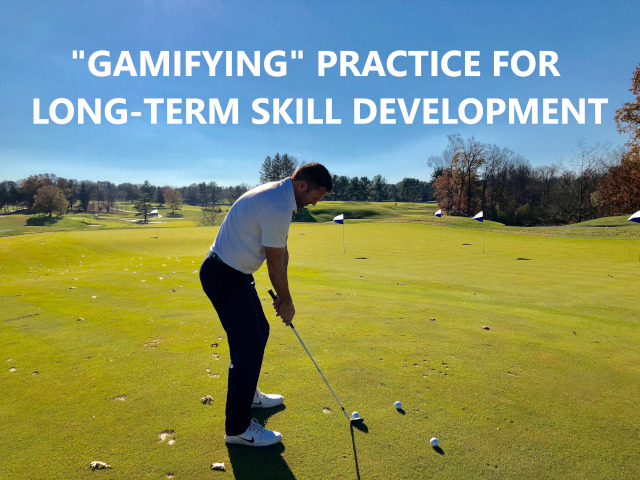
The Purpose of Block Practice
On the driving range, after you’ve hit several shots to the same target, you have the sensory feedback of the last swing and the outcome of the shot in your short-term memory. This allows you to (consciously and subconsciously) make small adjustments to your swing, which over the course of a bucket of balls, enables you to hit the ball straight. But what can look like effective practice and improvement, is more likely just a golfer using their short-term memory and not actually improving skills.
The equivalent would be a student that crams the night before a test – everything is in their short term memory and they might ace the test, but very little long-term learning has taken place. Those students who take the time to learn and understand the concepts over the course of a semester are more likely to retain and develop the skills to apply them longer-term.
I’m not saying that “Block practice” doesn’t have its place (in fact a beginner would benefit more by doing block practice) – the purpose being to consciously think about a movement that you are trying to change. But too many golfers do this excessively, at the expense of developing their playing skills. After a while, the focus on the movement they are trying to change shifts to focusing on hitting great shots (which after hitting 20 balls they are able to do quite successfully). But from your own experience, does this transfer to the golf course? In fact, the better you play in practice could actually mean less transferable skill development has taken place. There isn’t enough “challenge” to make those good swings stick.
This is where “Gamifying” practice comes in. Games can help us with long term skill acquisition and they also create pressure which simulates more of how we feel on the course. Hitting balls excessively on the driving range without consequence, does not. Additionally, successful completion of a challenges increases confidence.
Designing a practice session
To begin with, each practice session should have a goal. What is it that you are looking to improve with your practice session? This sounds obvious but many golfers just go to the range to “work on their swing”, without any real intent. This might be a technical improvement and you have a technical drill from your teaching pro to help you with it. After you’ve done your block practice, it’s time to “reset” and then test it later in your practice session.
So what games should you use to “test” what you’ve learned? The difficulty of the games will depend on your current skill level. If you’re a 28 handicap, your challenges won’t be as difficult as those for a scratch golfer. E.g. Getting up and down from 5 different spots around the green, would be a challenge that most 28 handicappers would struggle with and fail, making them feel unmotivated in the process. However, for a scratch golfer, getting up and down from 5 different spots would be a good challenge. Not an easy challenge by any means, but not impossible either.
Find Your Challenge Point In Practice
The optimal tasks and challenges for learning, are those that are neither too easy, or too hard for your current skill level. The level of challenge where learning has been proven to be at its highest rate is what Dr. Mark Guadagnoli and Timothy D. Lee calls the challenge point in practice. Use some drills like the following to find your challenge point in practice and work on increasing it with each practice session:
Full shot challenge
Give yourself a certain proximity to the hole for 3 targets: 200, 150 and 100 yards. The size of your circle around the target would represent your current challenge point or skill levels. You might start off with a bigger area to aim at for your first challenge and then increase the difficulty (by requiring better shots), with each practice session.
As a reference:
Tour player average proximity from 200 yds is 40ft
Tour player average proximity from 150 yds is 28ft
Tour player average proximity from 100 yds is 20ft
The aim of the game is to get 3 balls in a row into your target area
See how many balls it takes to get 3 in a row and record that number.
Challenges (like the one above) should always be a little frustrating – just as it feels on the course when you miss a shot. A big part of playing well on the course, is dealing with the emotional and physiological changes that come with that frustration and the challenges the game beings. Gamifying and finding the challenge point in practice trains us develop more resilience and mental toughness to deal with it.
Short game trajectory control challenge
Pick a spot to play 3 shots from around the green. For a lower handicap player, it could be a more challenging spot, such as an uneven lie, or rough. For a higher handicap player, the shots it could be a pretty basic chip shot from a flat lie with plenty of green to work with. You could also make it 2 shots instead of 3 for the higher handicapper.
Each of the 3 shots will have a different trajectory (low, medium and high).
Place a tee in the ground for where you intend the ball to land for each shot (so 3 tees in total).
The goal of the challenge is to get as close to landing spot (the tee) as possible and as close to the pin as possible.
When you have successfully hit 3 shots in a row within 3ft of the landing spot and within 6ft of the pin the challenge is completed. Increase the challenge point of any drill (what it takes to complete it) if it becomes too easy.
Additional constraints
To increase motivation and add pressure, you can add further rewards for completion or consequences for not completing a challenge. You can also take short breaks in between shots (like you have on the course), so that the previous shot is less in your short-term memory.
These are just a couple of hundreds of games which you can use to intensify practice and make it really count. Time is precious and we can’t waste it. Gamifying and finding your challenge point will lead to deeper your learning and better performance on the golf course.


